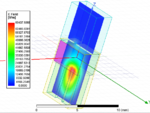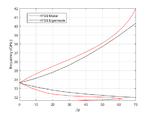teslameta
Newbie level 5
Hi there,
I am trying to replicate the results from this paper (https://ieeexplore.ieee.org/stamp/stamp.jsp?tp=&arnumber=8928575 [open access]) for a CRLH rectangular waveguide antenna with frequency scanning. I have successfully replicated their unit-cell dispersion diagrams within HFSS Eigenmode (see attached image) for the phase constant. In the paper they deduce the leakage constant of a meanderline slot in the via modal analysis of 5 unit cells. I am having a lot of trouble replicating this, observing that my simulations of the 5 unit cells have S21 & S11 above 0 dB in the left-handed region - i.e. the frequencies below the cut-off of the waveguide structure. Additionally, the modal solution report for gamma, shows an attenuation constant of zero at all frequencies - despite there being a 12mm slot cut in to the top wall of the waveguide. This happens irrespective of whether the structure is surrounded by PML or radiation boundaries. I have tested this report before using a standard rectangular waveguide with finite conductivity and match the attenuation constant exactly to theory & exports of s-parameters followed by rlgc conversion.
The last thing I tried was to include a waveguide transition from WR-28 to the CRLH waveguide dimension. It resolved the issues with positive s-parameters but did not affect the problem with the attenuation constant report. Ideally I would just like to simulate the structure without the transition.
I am completely at a loss as to what is going on here. I suspect there may be issues with port impedance and meshing. Could anyone offer any advice on how to solve this? I have attached a copy of the HFSS file (R19) and images of the Eigenmode, S-parameter results.
Thanks in advance!


I am trying to replicate the results from this paper (https://ieeexplore.ieee.org/stamp/stamp.jsp?tp=&arnumber=8928575 [open access]) for a CRLH rectangular waveguide antenna with frequency scanning. I have successfully replicated their unit-cell dispersion diagrams within HFSS Eigenmode (see attached image) for the phase constant. In the paper they deduce the leakage constant of a meanderline slot in the via modal analysis of 5 unit cells. I am having a lot of trouble replicating this, observing that my simulations of the 5 unit cells have S21 & S11 above 0 dB in the left-handed region - i.e. the frequencies below the cut-off of the waveguide structure. Additionally, the modal solution report for gamma, shows an attenuation constant of zero at all frequencies - despite there being a 12mm slot cut in to the top wall of the waveguide. This happens irrespective of whether the structure is surrounded by PML or radiation boundaries. I have tested this report before using a standard rectangular waveguide with finite conductivity and match the attenuation constant exactly to theory & exports of s-parameters followed by rlgc conversion.
The last thing I tried was to include a waveguide transition from WR-28 to the CRLH waveguide dimension. It resolved the issues with positive s-parameters but did not affect the problem with the attenuation constant report. Ideally I would just like to simulate the structure without the transition.
I am completely at a loss as to what is going on here. I suspect there may be issues with port impedance and meshing. Could anyone offer any advice on how to solve this? I have attached a copy of the HFSS file (R19) and images of the Eigenmode, S-parameter results.
Thanks in advance!
Last edited:

